Step Ups: Benefits, Muscles Worked, and More
In terms of functionality and elegance, few exercises compare to the step-up.
As the name implies, step-ups are simply a resistance exercise where the lifter will repeatedly step to and off a platform, training their lower body and eliciting a number of benefits.
Continue reading to learn how best to take advantage of step-ups, what muscles it works, and how to include it into your workout plan.
What are Step-Ups?
Step-ups are a highly dynamic open chain compound exercise performed either weighted or with the body’s own weight alone.
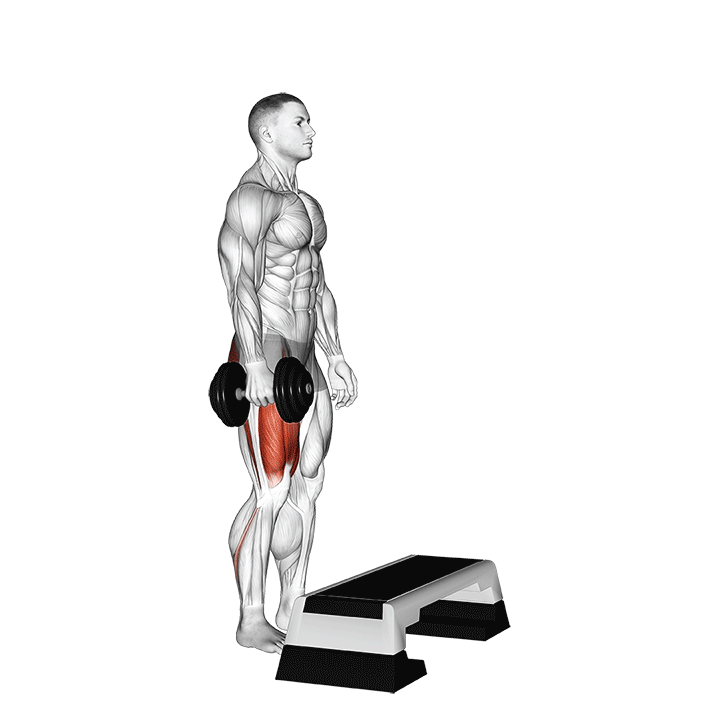
While primarily used to target the lower body, step-ups have also been used as a method of improving cardiovascular fitness, expending calories or for developing rhythm in athletes.
Although step-ups are traditionally performed equipment free, more advanced athletes may wish to increase the intensity of the exercise by gripping a pair of dumbbells or kettlebells in their hands.
Should You do Weighted or Unweighted Step-Ups?
Whether to carry additional weight or not during a set of step-ups will depend on your own personal training experience and goals.
If your training goals involve building cardiovascular or muscular endurance - or for any other purpose that requires greater volume and longer sets - then the unweighted variation may be better.
However, if you wish to build lower body strength or are otherwise too advanced for unweighted step-ups to present a challenge, then using additional weight may be warranted.
Are Step-Ups the Right Exercise for You?
Step-ups are a highly versatile and accessible exercise, meaning that they are used for a variety of purposes and are simple enough to be performed by novice exercisers.
However, if your training requires significant resistance or lower-volume high-intensity sets, then the step-up won’t provide the right kind of stimulus.
In addition, if you have a history of injuries or conditions that affect the spine, hips, ankles or knees - then it is best to consult a medical professional prior to performing step-ups.
How to do Step-Ups
To perform step-ups, the lifter will set a plyometric box or similar platform approximately one step in front of them. If performing the exercise with weights, they will also hold them at their sides.
Once appropriately set up, the lifter will contract their core, keep their spine aligned and step one foot atop the platform; The opposite leg will follow suit.
With both legs on the platform, the lifter will then return the first leg back to the ground, keeping themselves facing forwards as they do so.
Once both feet are returned to the ground, the repetition is considered complete. Repeat as many times as necessary.
What Muscles Do Step-Ups Work?
Step-ups are a compound exercise, meaning that more than one muscle group is used to complete the movement pattern.
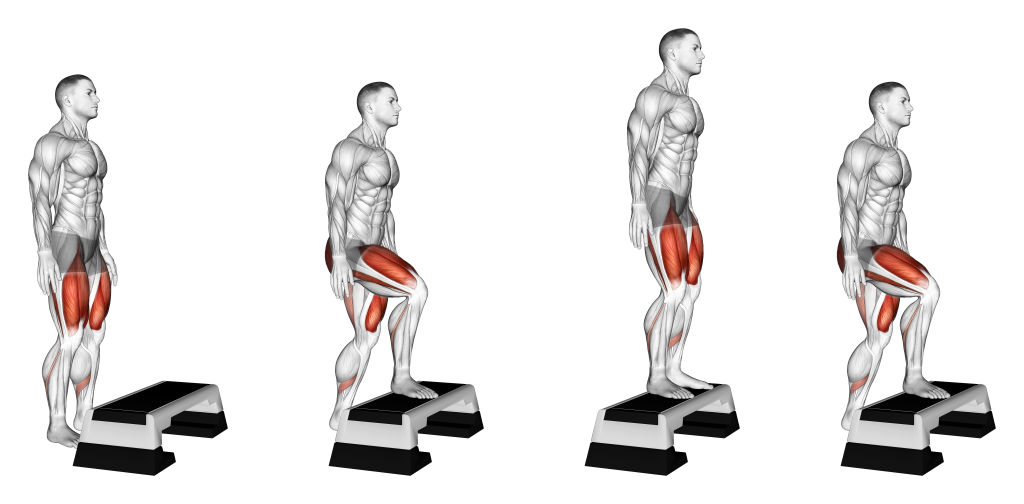
These muscles are divided according to the type of contraction that is utilized, with mover muscles featuring dynamic contraction, and stabilizer muscles featuring static contraction.
Mover Muscles
During a set of step-ups, the primary muscles worked are the quadriceps, glutes and hamstrings. In addition, the calves also play a secondary role.
Stabilizer Muscles
Apart from the primary and secondary mover muscles, step-ups also work the core musculature and the erector spinae.
What are the Benefits of Doing Step-Ups?
Step-ups are used in a variety of different training programs because of the large number of benefits it offers. We’ve listed the most generally-applicable ones below.
Builds Endurance, Strength, and Mass in the Legs
As a resistance exercise of significant volume and a highly dynamic movement pattern, step-ups are excellent for building up strength and muscle mass in the lower body. This includes muscles like the quadriceps, glutes and hamstrings - of which are the three largest muscle groups found in the legs.
Apart from general strength adaptation and muscular hypertrophy, step-ups are also great for training endurance in the lower body.
To truly gear the workout towards endurance, try programming step-ups with no weight and a significant number of steps per set. Otherwise, performing the weighted variation is better for gaining muscle mass and strength.
Functions as Both Aerobic and Anaerobic Exercise
Step-ups are rare in the fact that they can function as both aerobic and anaerobic exercise.
Because step-ups will both challenge the cardiovascular system and the muscles of the lower body, they are capable of imparting the benefits of both types of exercise.
The lifter can even emphasize aspects of either type of exercise by choosing to add further weight or not. Increasing the resistance will equate to less volume and sway more towards anaerobic exercise.
Burns Calories
With how dynamic and high-volume the step-up is, it's no surprise that exercisers and athletes of all sorts use it for inducing caloric expenditure. This can be taken a step further by upping the tempo of each step - increasing the performer’s heart rate and therefore burning away more calories.
We suggest combining step-ups with another calorie burning exercise that works the upper body, such as using a rowing machine.
Remember to also structure your diet for a caloric deficit in order to truly lose weight with step-ups.
Improves Flexibility of the Lower Body
Step-ups are excellent for improving the mobility and flexibility of the lower body - muscles and joints included. Because of the wide stepping motion that the exercise features, the glutes, hamstrings and the hip joint are all worked through a full range of motion.
For an even greater stretching effect, try performing each repetition in a slow and controlled manner, and choosing a higher platform to step on to.
Of course, this doesn’t mean you should perform step-ups if you possess poor mobility in the lower body.
Ensure that a full mobility drill is performed prior to beginning the exercise.
Common Mistakes Made While Doing Step-Ups
Although step-ups are indeed quite easy to learn, avoid the following commonly made mistakes as they can lead to poor development or injury.
Poor Knee Tracking
In order to ensure that the knees aren’t subjected to excessive pressure, it is important to keep the knees behind the toes throughout the entire exercise.
This particular mistake is especially dangerous during the initial movement of the first leg, where leading with the knee will place the entirety of the lifter’s weight onto said knee.
Driving Off the Behind-Leg
During the movement pattern of the step-up, it is important to properly contract the quadriceps and to leverage the leg already on the platform. This means avoiding driving through the leg still on the ground once the first leg is already raised.
Pigeon-Toeing or Knee Valgus
Think of the step-up like walking - knee valgus or becoming "pigeon-toed" leads to a less efficient movement pattern and greater difficulty maintaining balance.
For the most stable and safe stance, it is best for the feet to point forwards or slightly outwards. In addition, the lifter should strive to avoid turning the knees inwards at any point during the exercise.
Not only will angling the toes inwards result in worse balance, but it will also draw the rest of the lower body into a disadvantageous position. Likewise, allowing the knees to collapse towards one-another may draw the femur into a poor position as well.
Failing to Keep the Torso Upright
In order to maintain a proper center of gravity and to protect the spine, it is important to keep the torso straight and upright.
The lifter can achieve this by properly bracing the abdominals, keeping the shoulders in a neutral rotation and keeping the head aligned with the body.
Although step-ups are markedly far less dangerous to the back than other leg exercises, taking due precaution is a smart idea.
Alternatives to Step-Ups
If step-ups aren’t quite the exercise you need, try out these three similar alternatives.
Mountain Climbers
Mountain climbers are a far more intense and core-focused substitute to the step-up.
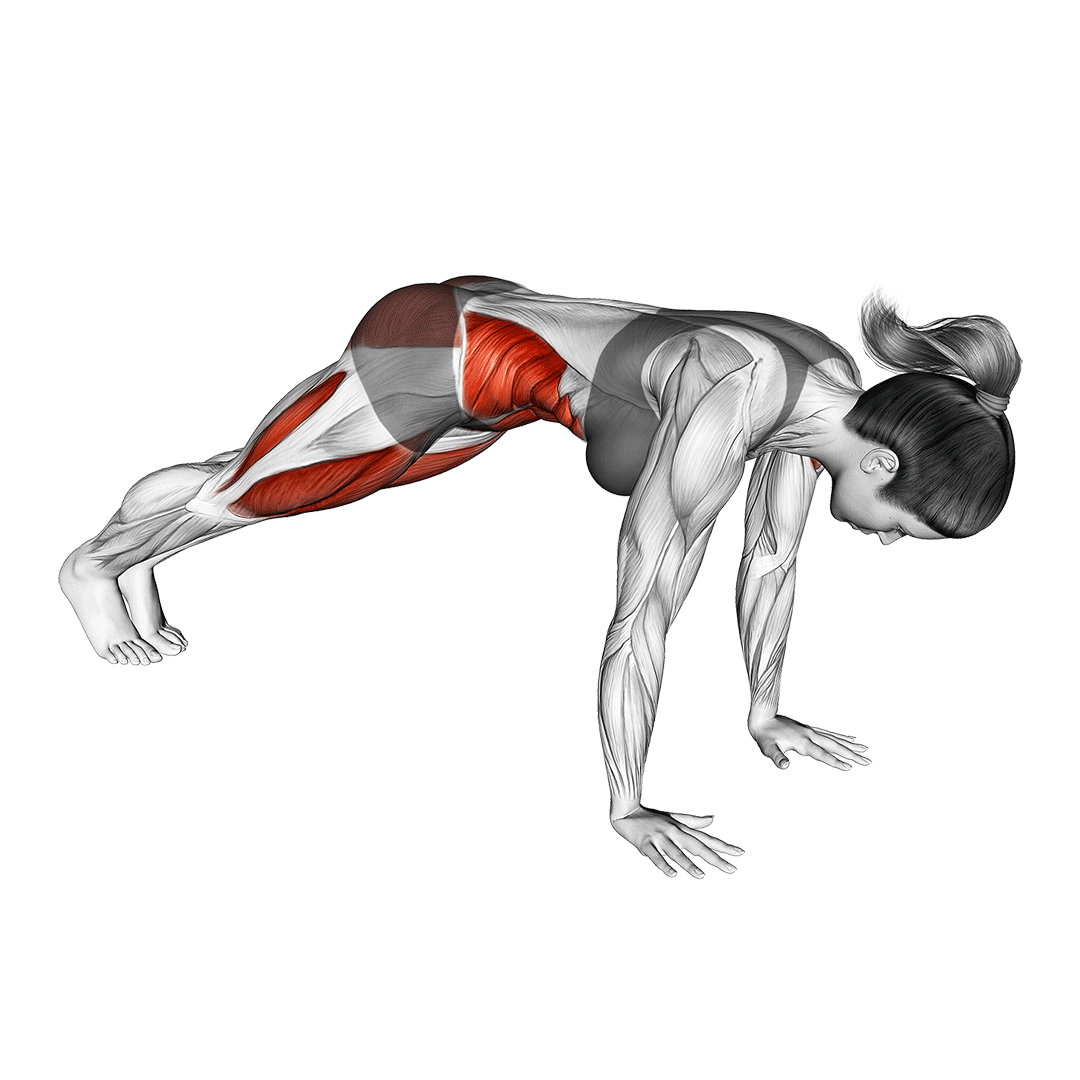
Unlike the latter exercise, mountain climbers are performed in a bent-over position, and are a closed chain exercise as the hands remain in place all throughout the set.
Mountain climbers are the ideal substitute to step-ups for individuals who want to retain its calorie-burning and athletic benefits, but find their leg musculature to be too fatigued.
Walking Lunges
Walking lunges serve the opposite purpose to mountain climbers as a substitute.
Rather than sharing the same tempo, volume and cardiovascular focus, walking lunges instead focus far more on training the lower body’s musculature.
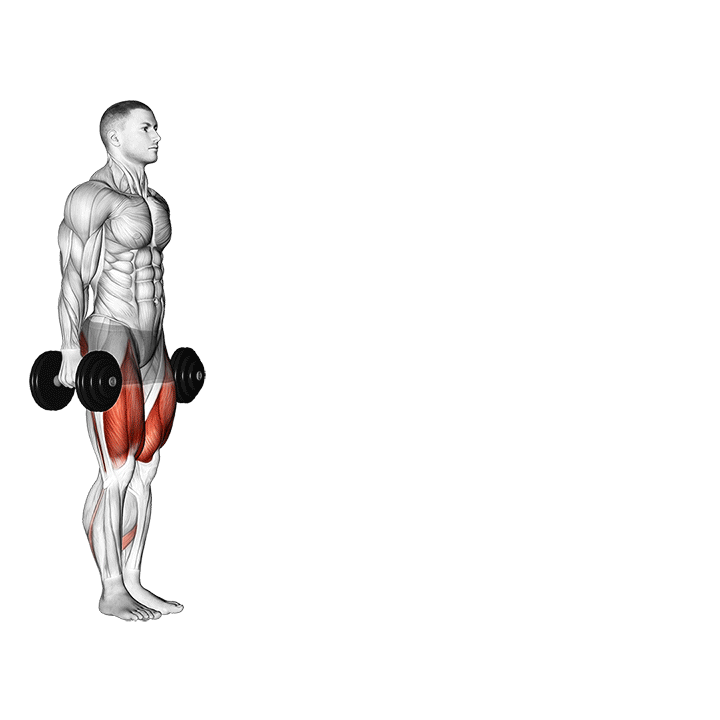
Generally, walking lunges will function better at inducing muscular hypertrophy and strength developments than the step-up - especially if performed with the addition of free weights.
If performing walking lunges as a muscle building alternative to the step-up, remember to reduce the volume of each set.
Sled Pushes
To take the step-up’s power and endurance benefits to the next level, try out sled pushes.
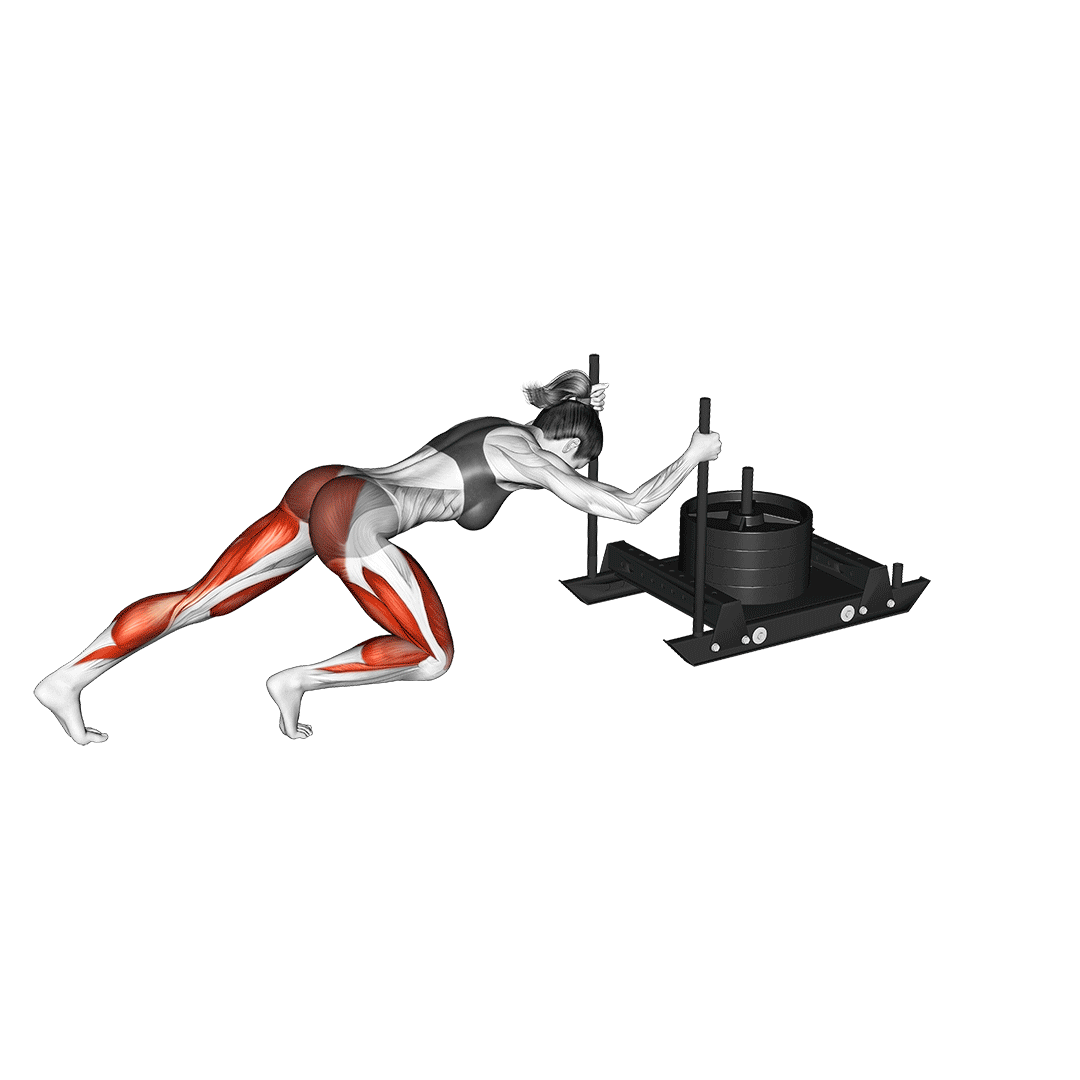
As one can guess from the name, sled pushes are an exercise where the performer pushes a loaded workout sled for a certain length of time or distance.
This challenges the entirety of the body, and is considered one of the most effective endurance and power builders out there.
How to Program Step-Ups as Part of an Athletic Training Drill
Because of step-ups moderate joint impact but variable intensity, including it in a training drill will require playing around with its placement in the order of exercises.
Sets X Reps
Depending on the goal of the athlete, the total step-up volume can also be adjusted.
Generally, for strength or hypertrophy, 3-4 sets of 8-15 repetitions may suffice.
However, for weight loss, cardiovascular training or endurance, 4-5 total sets of 15-25 repetitions over the entire drill will suffice.
Of course, being an athletic drill, these sets may be interspersed between those of other exercises. Remember to add up total repetition volume to ensure you’re getting enough.
Placement
Generally, you’ll want to place step-ups after exercises that heavily tax the leg muscles - but not so late in the drill that the exercise will be performed suboptimally.
For example, in the following soccer athlete drill:
Burpees (8 repetitions)
Jump Squats (8 repetitions)
Step-Ups (15 repetitions)
Cone Weaves (15 repetitions)
Medicine Ball Slams (6 repetitions)
Repeat (3x)
As can be seen from the example above, step-ups are not the immediate exercise and as such will not worsen performance of jump squats or burpees, but nonetheless take precedence over the less intensive cone weave drills.
Note that this programming is different for weightlifting training plans, as the programming of athletic drills generally follows an exercise-to-exercise cycle, rather than successively completing multiple sets of a single exercise.
Frequently Asked Questions (FAQ)
How Many Step-Ups Should I do?
Generally, you’ll want to match the total step-up volume of your workout with your current needs and experience level.
A good guideline to follow is to aim for lesser and heavier repetitions (8-15) for strength, and to aim for more (15-25) for cardio.
When Should You Do Step-Ups?
Step-ups are excellent as an initial exercise, but the high volume may cause certain muscle groups to become fatigued if performed prior to heavier (and riskier) exercises.
As such, we advise placing step-ups as early in your workout as possible so long as they do not interfere with the performance of other exercises.
Are Step-Ups Cardio or Strength?
Both.
Step-ups will challenge both your cardiovascular system and the skeletal muscles of your lower body.
If so desired, you can also alter how your step-ups are performed in order to focus more on cardio or strength. Adding weight and performing fewer repetitions is excellent for the latter, while less weight and more volume allows for greater cardio.
A Few Reminders
As great as step-ups are, they may be inefficient or just too easy for more advanced athletes. In such cases, you can add more weight to up the intensity, or otherwise try out an alternative exercise.
Remember that - apart from weight and volume - you can also change the height of the platform to increase difficulty. A higher platform will mean more leg drive will be needed, and each repetition will be more demanding.
Finally, remember to first consult a physician prior to attempting any sort of intense physical activity. Avoid step-ups if you are a fall risk, have an impaired gait or a history of lower body injury.
References
1 Vicki Stemmons Mercer and others, Comparison of Gluteus Medius Muscle Electromyographic Activity During Forward and Lateral Step-up Exercises in Older Adults, Physical Therapy, Volume 89, Issue 11, 1 November 2009, Pages 1205–1214, https://doi.org/10.2522/ptj.20080229
2 Lorenz, Daniel. (2011). Postactivation potentiation: An introduction. International journal of sports physical therapy. 6. 234-40.

